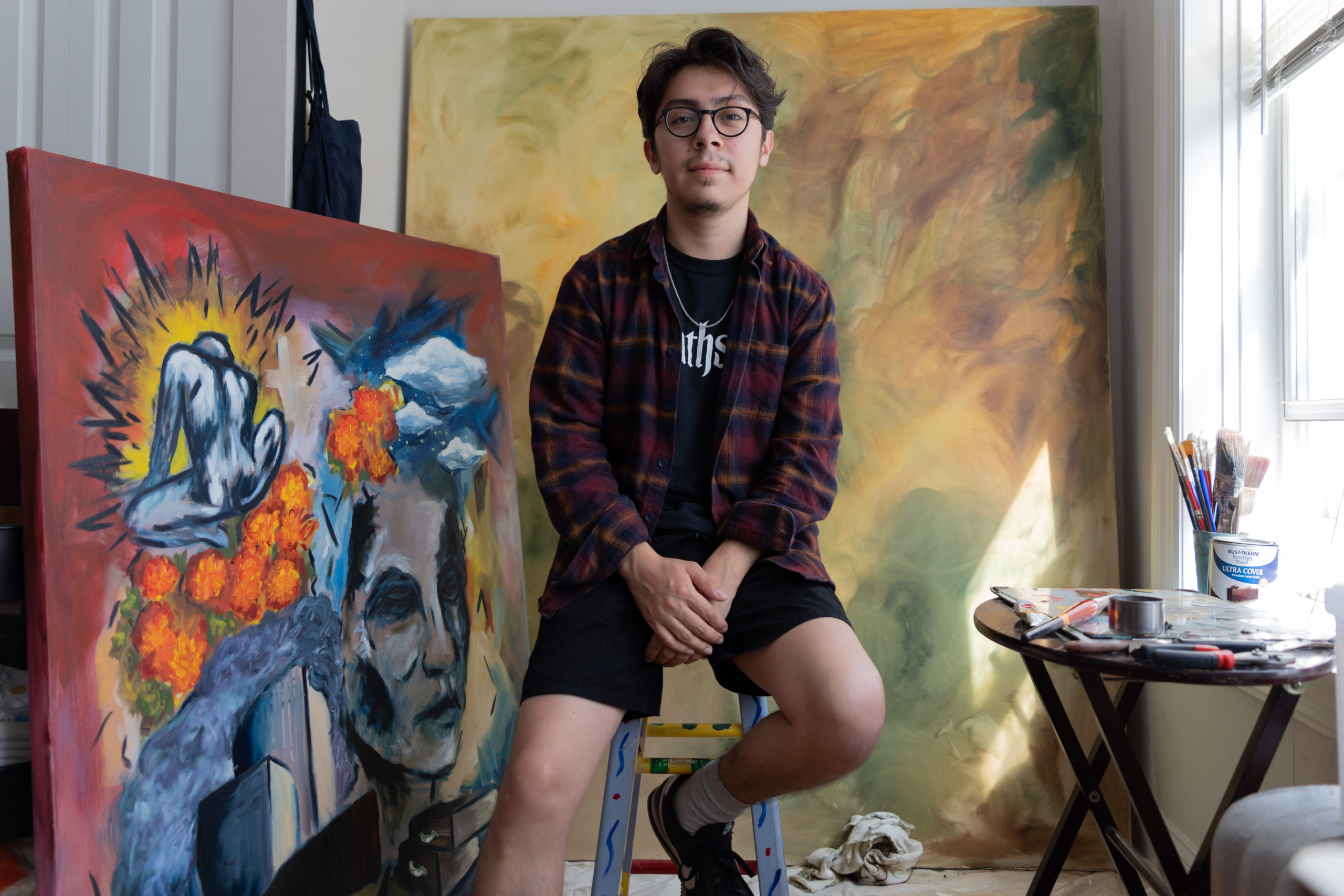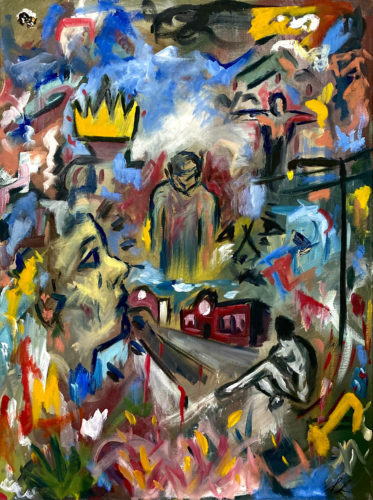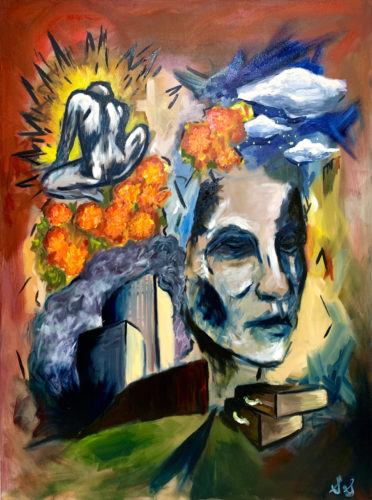Sebastian Silverio’s art explores the reality of living in a neighborhood experiencing chronic violence and disinvestment. His work draws on his experiences as the child of undocumented immigrants—exploring how gentrification, immigration enforcement, and environmental injustice impact his community. Silverio uses his perspective to draw attention to these issues and call for change.
Inspired by neo-expressionism and abstract portraiture, he uses art to tell meaningful stories about survival and resistance in his community. By representing his own stories and those of his community, he hopes to create art that people can see themselves in. Not only does his work ask us to look at the realities of these situations, but it asks us to work together to come up with solutions and empower one another.
South Side Weekly spoke with Silverio about his art practice, art as activism, and how Little Village inspires his work. This interview has been condensed and edited for clarity.
How do you describe yourself as an artist?
I grew up on the Southwest side of Chicago in Little Village. My main focus is using oil painting to capture childhood and life and what growing up was like in a neighborhood like Little Village—how all that ties together and creates a tiny section in Chicago that is one of a kind.
When did you first become an artist? When did you know you wanted to start creating things?
It’s something I’ve always done, but as far as the art that I do now, I want to say that started maybe when I was nineteen years old, fresh out of high school, and realizing that I want to keep making art but making art that really means something and has something more to offer.
I’m curious to know how Little Village inspires your work. A lot of your pieces focus on environmental injustice or immigration and how these issues impact your community. What was your thinking behind some of the pieces?
I’m a child of undocumented immigrants. I can remember being a kid and my parents fearing deportation. That’s something that’s always followed me through childhood.
I went to elementary school at Saucedo, which is right on 24th and California. That area is where I basically did everything my entire childhood. My mom primarily worked from home, so we spent a lot of time together. At that time, my mom didn’t drive, so we walked everywhere, and the simple act of walking throughout your neighborhood every single day as a child—there are images that you see all the time. So the Arch in Little Village on 26th Street—something I saw every single day—that really iconic and beautiful image is a big part of me.
All the little stores and every detail there in Little Village is something that, even though I don’t live there now, it’s still something I want to keep representing in my work. We see a lot of Chicago representation as a whole, as a city in its entirety, but there are so many little subsections, and I want that to come out as well.
There’s a lot of beauty in Little Village and my home. When that beauty gets threatened and the people in those communities get threatened, that’s something that hits even closer to home and hurts even more. Because these are people I grew up with and places I saw every single day growing up, it’s something that makes me want to fight back in whatever way I can.
Why is it important to represent your neighborhood through art? What is the relationship between art and activism for you?
Art and activism—they’ve always been so closely tied. I personally want to represent my home in the best way I can, especially when there are a lot of people that get taken advantage of there. Local government and local aldermen don’t do what they should be doing to protect the interests of the people. A lot of the time, they’re so disconnected from what the community actually is. I want the truth to be told and the actual views of people without any conflicts of interest. I feel my duty as an artist is to try to encapsulate that as well as I could.
What’s your favorite piece that you’ve gotten the chance to work on?
I really enjoyed the “HellNoHilco” piece I did. I wanted the community to see this and be able to tell our story in the best way I could. Because while it did get media coverage, what happened—the Hilco demolition that created the big dust cloud in the Little Village neighborhood—didn’t seem to be as important as it should have been, especially during that time when we were still very much under strict COVID lockdown guidelines. Another piece I really enjoyed was one I did fairly recently—I actually took inspiration from José Olivarez’s poem, “My Parents Fold Like Luggage”—and in that piece, I explored my parents’ immigration journey, but also that and its relationship with spirituality and the different perspectives of what it means to immigrate to the US and have it not all be like the grass is always greener on the other side. I tried to capture their journey and the hardships that came with it.

Can you walk me through your process of working on these paintings?
The first couple pages of my sketchbook are just words and sentences that I’ll write, and I use that to try to capture what themes I want to capture in pieces before even coming up with any images. From there, I will do small sketches of the overall composition. When I actually get in front of a canvas is when I start to embrace the spontaneous ideas that come in that moment. It’s almost like a dance—dancing with your canvas and letting it speak to you. As you’re working on it, the painting almost takes a life of its own.
What do you want to evoke through telling stories about your family or community?
I know these personal stories are also stories that so many other people, like me, have gone through. I want others to see themselves in these artworks as well. It’s not about me, but it’s about community. More than anything, I want people to look at artwork and see themselves in it and feel like they’re also part of it.
Can I ask what you’re most proud of with your work? What do you hope people take away from it when they’ve seen one of your paintings?
I want people to see beauty, in spite of sometimes heavy subject matter. Because once they see beauty, it feels easy to digest, but not in a sugarcoating way. If people see this and get comfortable with a subject, maybe something else can happen. Maybe some people can take action. I want people’s takeaway from my work to be to genuinely enjoy interacting with art and enjoying seeing that painting, seeing themselves in it, and having a relationship with art that sometimes people are scared to have.
What would you tell someone that was getting into visual art for the first time?
My first thing of advice will be: look at as much art as you can. Go to museums, go to galleries, and even follow a bunch of artists on Instagram. Consume as you can, because looking at all that is going to make you so much better. It’s going to creatively fuel you. Immersing yourself in creative environments is what really makes art perfect.
What comes next for you as an artist? Where do you hope to be?
My biggest goal is to be able to quit my day job and be an artist full-time. But also my goal is to get my artwork out there—have people see it, have people criticize it, get a bigger development platform, and have my name a little more known in the city. I have so much love for a lot of artists already that are established in Chicago, and I would love to be part of that community.
Reema Saleh is a journalist and graduate student at the University of Chicago studying public policy. She last reviewed José Olivarez’s debut poetry collection Citizen Illegal.



